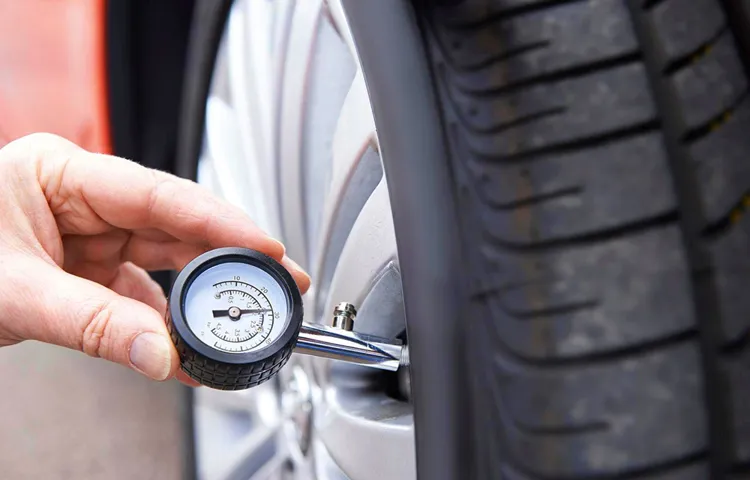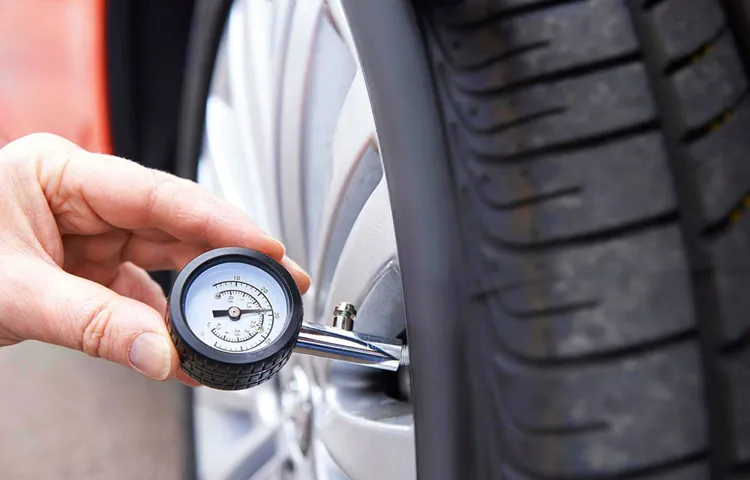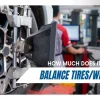Have you ever noticed that one of your tires loses pressure faster than the others? It’s a common issue that can cause inconvenience and safety hazards if left unaddressed. But what causes it, and can it be fixed? In this blog, we’ll explore the reasons why one tire may be losing pressure at a faster rate than the others and what you can do to resolve the problem. So, sit tight and let’s dive into the world of tires!
Table of Contents
Introduction
Have you ever noticed that one of your tires seems to lose pressure faster than the others? Maybe you’ve filled them all up to the same level, only to find that one in particular is noticeably lower the next time you check. So why does this happen? There are a few possible reasons, but one of the most common is simply uneven wear and tear. If one tire has a slightly damaged valve stem, for example, or if there’s a small leak somewhere in the rubber, it may lose pressure more quickly than the others.
Additionally, tires that are more worn down may be less effective at retaining air, meaning that they may need more frequent top-ups. In any case, it’s important to keep an eye on your tire pressure to ensure that you’re staying safe on the road.
Common issue for many drivers
As a driver on the road, you may have encountered a common issue that plagues many drivers: the dreaded flat tire. Whether it’s caused by a pothole or a sharp object on the road, getting a flat tire can be a major inconvenience and even a safety hazard. The last thing you want is to be stranded on the side of the road with a flat tire, especially if you don’t know how to change it.
But fear not, because changing a tire is actually a fairly simple process that anyone can learn. By keeping a few key tools in your car and following a few basic steps, you can be back on the road in no time. So don’t let a flat tire ruin your day – learn how to change it and be prepared for anything that comes your way on the road.

Importance of tire pressure for safety and performance
Tire pressure is a critical element when it comes to ensuring the safety and performance of your vehicle. Properly inflated tires help maintain a smooth ride, improve fuel efficiency, and increase the lifespan of your tires. On the other hand, underinflated or overinflated tires can lead to a range of issues, such as poor handling, reduced braking performance, and increased risk of tire failure.
That’s why it’s crucial to check your tire pressure regularly, ideally at least once a month, to ensure it’s at the recommended level specified by your vehicle’s manufacturer. By doing this, you’ll not only enhance your safety on the road but also extend the life of your tires and maintain optimal performance on various road conditions.
Causes of Uneven Tire Pressure
If you’ve noticed that one of your tires seems to constantly lose pressure faster than the others, it can be frustrating and concerning. There are several reasons why this might be happening. Firstly, it could be due to a slow air leak caused by a puncture or damage to the tire.
Another possible cause could be a problem with the valve stem, which can become damaged or corroded over time. It’s also worth checking the wheel itself, as a bent or damaged wheel can cause uneven pressure distribution. Additionally, changing temperatures can cause changes in tire pressure, so it’s important to regularly check and adjust your tire pressure according to the manufacturer’s recommendations.
It’s always a good idea to have your tires checked by a professional if you’re experiencing ongoing issues with tire pressure. By identifying and addressing the underlying cause, you can help ensure your safety while driving and prolong the lifespan of your tires.
Punctured or Damaged Tires
If you’ve been noticing uneven tire pressure, the cause could very well be a punctured or damaged tire. Punctures can happen in various ways, from driving over a sharp object on the road to hitting a curb or pothole. Any damage to your tire’s tread or sidewall may cause a leak and result in uneven tire pressure.
It’s essential to keep an eye out for signs of a puncture or damage, such as hissing noises, decreased handling, vibrations, or visible wear and tear. Neglecting these issues may lead to complete tire failure, making your vehicle unsafe to drive. In such cases, it’s best to seek immediate professional help and get punctured or damaged tires repaired or replaced.
Remember, maintaining your tires’ health is crucial for your safety and the longevity of your vehicle, so don’t overlook any signs of punctures or damage.
Tire Age and Wear and Tear
Uneven tire pressure is a common problem faced by many drivers, and there are several causes for it. One of the primary reasons for uneven tire pressure is the age and wear and tear on the tires. As the tires get older, their ability to hold air decreases, resulting in uneven pressure.
Uneven wear and tear on the tires can lead to a similar result. If one part of the tire is damaged or worn out more than the rest, the pressure in that area will be different from the others, causing uneven tire pressure. Additionally, driving on uneven roads or hitting potholes and speed bumps can also lead to uneven tire pressure.
It’s essential to check your tire pressure regularly, especially when you notice that your vehicle is pulling to one side or a part of the tire has visibly bulged out. Driving on tires with uneven pressure can be dangerous, as it affects the handling of the vehicle, and can even lead to a blowout. Remember always to maintain the correct tire pressure levels recommended for your vehicle by the manufacturer.
Issues with the Rim or Valve Stem
Uneven tire pressure can be caused by issues with the rim or valve stem. The rim is the outer edge of the wheel that gives it shape and structure. When the rim gets dented or damaged, it can cause a leak in the tire’s air pressure.
Similarly, the valve stem is the small tube that protrudes from the rim and allows you to inflate or deflate the tire. If the valve stem is damaged or missing a cap, air can escape from the tire, leading to uneven tire pressure. It’s important to check the condition of the rim and valve stem regularly and repair or replace them if necessary to ensure proper tire pressure and maintain safe driving conditions.
So next time you suspect an issue with your tire pressure, don’t forget to inspect the rim and valve stem as potential causes.
Factors That Affect Tire Pressure Loss
Have you ever wondered why one tire on your car seems to lose pressure faster than the others? There are several factors that can contribute to this. One common reason is a slow leak caused by a puncture or small tear in the tire. Another factor is the temperature outside, as the air molecules in your tires contract in colder temperatures, causing pressure to drop.
Similarly, driving on hot pavement can cause your tires to heat up and increase pressure, which can lead to pressure loss when they cool down. Additionally, old or worn-out tires can also be prone to losing pressure more quickly than newer, better-maintained tires. Remember to check your tire pressure regularly and address any issues promptly to ensure optimal safety and performance on the road.
Temperature and Weather Changes
Temperature and Weather Changes impact the tire pressure of your vehicle. It is vital to keep an eye on the tire pressure and maintain it regularly. The temperature change causes the air inside the tire to expand or contract, leading to tire pressure loss.
For instance, during summers, the air inside the tire expands, which leads to an increase in tire pressure. Conversely, in winters, the air inside the tire contracts, decreasing the tire’s pressure. Apart from the temperature change, weather conditions like rain and snow also pose a threat to tire pressure.
Driving on wet roads or through puddles may lead to water entering the tires, ultimately causing air leakage. Therefore, checking tire pressure regularly and maintaining the recommended pressure is crucial to ensure your safety on the roads. A low tire pressure may lead to tire blowouts and accidents, costing you much more than basic tire maintenance.
Thus, keep your tires inflated according to the weather and temperature conditions, and get them checked by a professional to avoid any mishap.
Driving Style and Vehicle Speed
When it comes to maintaining the proper tire pressure for your vehicle, there are a variety of factors to consider. One of the most important of these is your driving style and the speed at which you typically travel. If you frequently drive at high speeds or engage in aggressive driving behavior like hard braking or rapid acceleration, your tires are much more likely to experience pressure loss.
This is because these behaviors generate a lot of heat, which can cause the air inside your tires to expand and escape. Additionally, high speeds often lead to more severe impacts with potholes, speed bumps, or other road hazards, which can also cause tire damage and leakage. To avoid these issues and prolong the life of your tires, it’s important to practice safe driving habits and pay close attention to your tire pressure levels on a regular basis.
That way, you can ensure that your vehicle is performing at its best and keep yourself and your passengers safe on the road.
Tire Type and Inflation Amount
When it comes to maintaining proper tire pressure, two factors come into play: tire type and inflation amount. Different tire types require different inflation amounts to perform optimally. For example, a car with larger tires will require more air pressure than a car with smaller tires.
Additionally, the type of tire can also affect its ability to maintain adequate pressure. Radial tires, for instance, are known to lose pressure more slowly than bias-ply tires. It’s also essential to note that overinflation and under-inflation can both be detrimental to the longevity and performance of your tires.
Overinflated tires can cause rough rides and less traction, while underinflated tires increase fuel consumption and can lead to tire blowouts. So, it’s always important to make sure your tires are inflated to the manufacturer’s recommended pressure level for your specific tire and vehicle model. Keep in mind that regular tire pressure checks are essential as changes in temperature and wear affects tire pressure.
By maintaining your tire pressure, you prolong the life of your tires and ensure your safety while driving.
How to Detect and Fix Uneven Tire Pressure
If you’re constantly noticing one tire losing pressure faster than the others, it could be a sign of uneven tire pressure. This can happen for a variety of reasons, including temperature changes, a puncture, or a faulty valve stem. The simplest way to detect uneven tire pressure is by using a tire pressure gauge to measure each tire’s PSI.
If there is a significant difference between the readings, it’s time to address the issue. To fix this problem, start by inflating all of your tires to the recommended pressure level. You can usually find this information on your vehicle’s tire placard or in the owner’s manual.
It’s also a good idea to check your tire pressure regularly, especially before long drives, to ensure your safety and the longevity of your tires.
Checking Tire Pressure Regularly
Tire pressure is one of the most crucial aspects of car maintenance that many drivers tend to overlook. It’s essential to check your tire pressure regularly, as uneven tire pressure can cause a host of problems while driving. One way to detect if your tire pressure is uneven is to observe the tread wear.
If your tire pressure is too high or too low, your tire tread will show uneven wear, which can lead to dangerous driving conditions. To fix this problem, you need to visit a mechanic, who will check the pressure and adjust it accordingly. Alternatively, you can invest in a tire pressure gauge, which is an affordable and handy tool to measure tire pressure yourself.
Regularly checking your tire pressure is an easy and inexpensive way to ensure your car is performing at its best, so be sure to make it a part of your car maintenance routine.
Identifying Signs of Uneven Tire Wear
Uneven tire wear is not only unsightly, but it can also lead to a dangerous situation while driving. If left unchecked, it can cause your tires to deteriorate faster, leading to increased problems down the road. To identify early signs of uneven tire wear, you need to pay attention to the tread on your tires.
Check to see if any areas are worn down more than others, or if there are any noticeable bulges or abnormalities. Uneven tire wear can result from a number of factors, including a lack of regular tire rotation, wheel misalignment, and incorrect tire pressure. To ensure proper tire pressure, you should check your tires regularly, especially before long drives.
Over-inflated or under-inflated tires can cause uneven wear, leading to tire failure and possible accidents. By following these simple tips and taking care to maintain your vehicle properly, you can extend the life of your tires and enjoy a safer driving experience.
Addressing the Cause of the Uneven Pressure Loss
Uneven tire pressure can cause a lot of discomfort, especially when driving long distances. It’s important to keep an eye on your tires regularly to detect and fix any uneven pressure loss. The first step is to check the recommended tire pressure for your vehicle, which you can find in the car manual or on a sticker located on the driver’s side door jamb.
A simple way to check the pressure is to use a tire gauge that can measure the amount of air inside the tire. If you find that some of the tires are under-inflated, fill them up with the recommended amount of air to match the others. It’s also essential to check for any punctures or damage to the tires that may be causing the pressure loss.
A visual inspection of the tire tread and surface can help identify any issues. Fixing uneven tire pressure not only helps ensure a comfortable and smooth ride, but it also helps improve the overall lifespan and safety of your tires. So, always stay vigilant and make sure your tires are in good shape.
Conclusion
After much research and contemplation, it appears that the culprit behind uneven tire pressure is none other than physics itself. As air molecules within the tire collide and transfer energy, some molecules escape through the rubber, resulting in a slow but steady loss of pressure. However, other factors such as temperature, road conditions, and even the tire’s specific construction can also play a role in this phenomenon.
So, the next time you find yourself with a flat tire, don’t blame the tire – blame science! But don’t worry, just keep monitoring your tire pressure regularly to avoid any sudden surprises on the road.”
Importance of Maintaining Tire Pressure
Maintaining proper tire pressure is essential for safe and efficient driving. Uneven tire pressure can lead to a range of issues, including reduced fuel efficiency and increased wear on your tires. Thankfully, identifying and fixing uneven tire pressure is a relatively straightforward process.
The first step is to check your tire pressure regularly using a tire pressure gauge. This tool allows you to accurately measure the air pressure in each tire. If you notice that one tire has a significantly lower pressure than the others, it might require additional air.
On the other hand, if one tire has more pressure than the others, you may need to release some air. You can find the recommended tire pressure for your vehicle in the owner’s manual or on the tire information label inside the driver’s door. It’s important to note that uneven tire pressure can indicate a bigger issue, such as a leak or puncture.
If you notice consistently uneven tire pressure, it’s a good idea to have a professional inspect your tires for damage. By keeping your tire pressure balanced, you can avoid unnecessary expenses and increase your vehicle’s lifespan.
Tips for Preventing Uneven Pressure Loss
Uneven tire pressure can lead to uneven wear on your tires, decreased fuel efficiency, and even unsafe driving conditions. To prevent the risk of uneven pressure loss, it’s recommended that you frequently check your tire pressure and make adjustments as necessary. This can be done easily with a tire pressure gauge, available at any auto parts store.
If your tires lose pressure at different rates, it may indicate a leak or other issue that needs to be addressed. To fix this, you may need to have your tires balanced or rotated, or have the leak repaired by a professional mechanic. By taking proactive steps to maintain even tire pressure, you can prolong the life of your tires and ensure a safe and comfortable driving experience.
FAQs
Why does one tire lose pressure faster than the others?
One tire may lose pressure faster due to a slow leak, a damaged valve stem, or a puncture in the tire.
How often should I check my tire pressure?
It’s recommended to check tire pressure at least once a month, and before long trips or when temperature changes occur.
Does overinflating or underinflating tires affect how fast they lose pressure?
Yes, overinflating or underinflating tires can cause them to lose pressure faster and may also lead to uneven wear on the tire.
Can the type of tire affect how fast it loses pressure?
Yes, the quality and type of tire can affect how fast it loses pressure. Cheaper tires may have poorly designed valves or thinner sidewalls that are more prone to leaks.
Can extreme weather conditions cause a tire to lose pressure faster?
Yes, high temperatures can cause the air in the tire to expand and escape, resulting in pressure loss. Similarly, low temperatures can cause the air to contract, leading to underinflation.
Is it safe to drive on a tire with low pressure?
It’s not recommended to drive on a tire with low pressure as it can cause uneven wear, decreased handling, and even a blowout in extreme cases.
How can I prevent tires from losing pressure quickly?
Regularly checking tire pressure, maintaining proper inflation levels, avoiding overloading your vehicle, and avoiding driving on rough terrain can all help prevent tires from losing pressure quickly.




